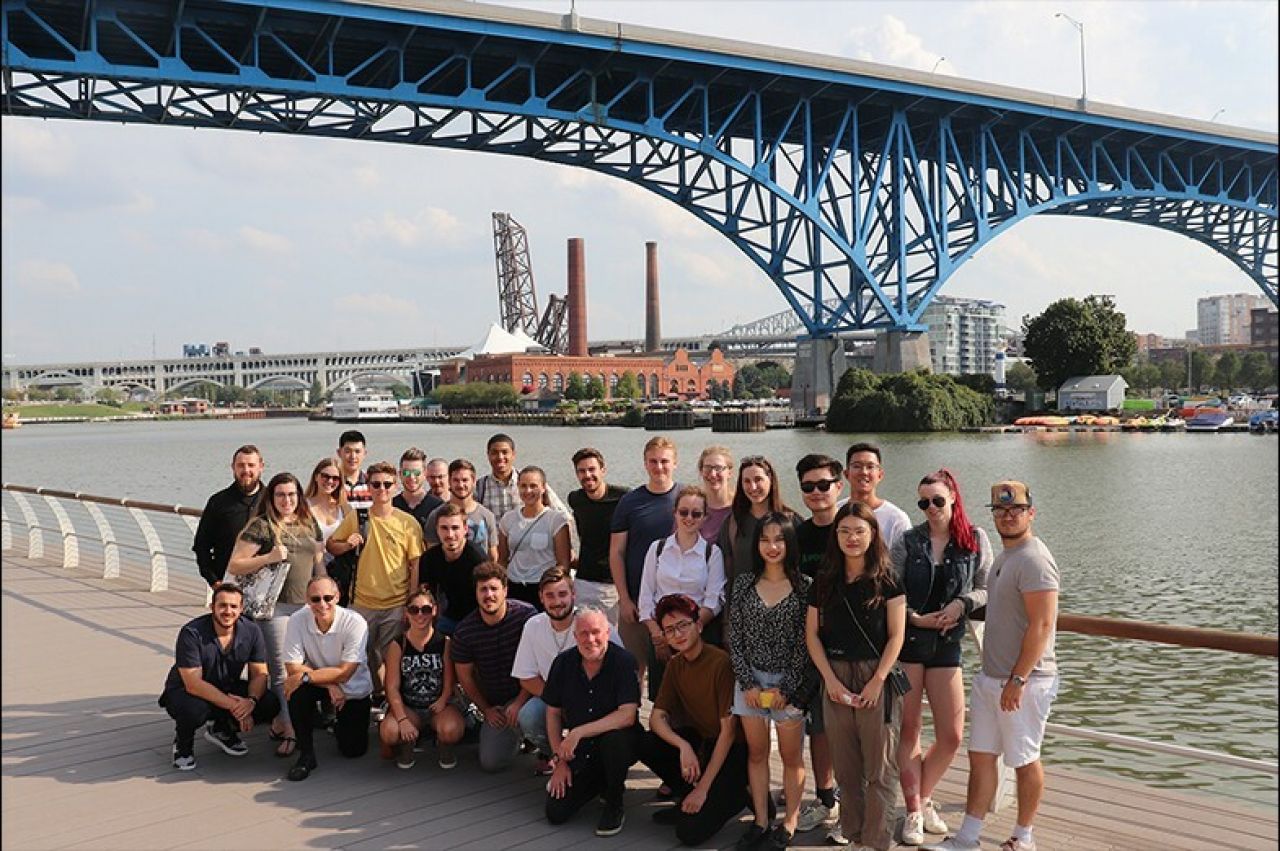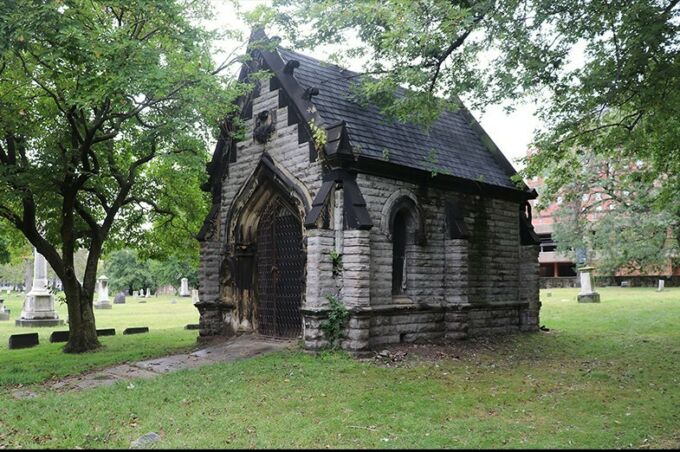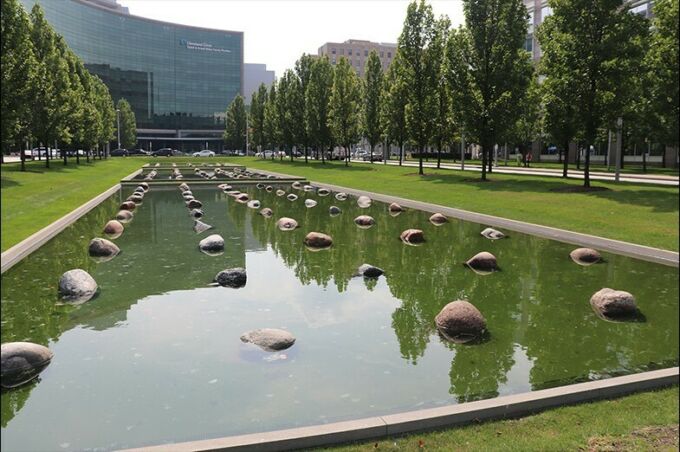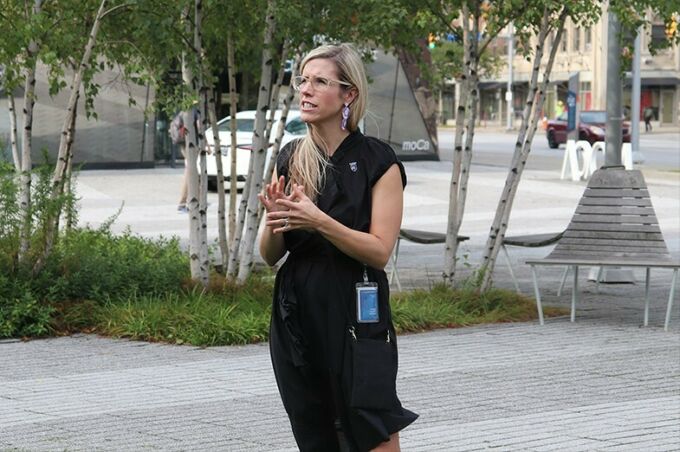April 29, 2020
Stuckeman School studio breaks down disciplinary lines through design

UNIVERSITY PARK, Pa. – The fall 2019 semester kicked off the second year of an upper-level collaborative studio in the Stuckeman School, which pairs advanced architecture and landscape architecture students together to develop a mixed-use design project adjacent to the successful Playhouse Square district in downtown Cleveland.
The concept of the studio was developed by Dan Willis, Professor of Architecture, to offer students more opportunities to work across the disciplines of architecture and landscape architecture. Willis wrote a grant proposal for the concept a few years back titled “Stuckeman Sustainable Urban Density Studio” or SSUDS, which was approved by then-School Director Kelleann Foster.
“The goal of the SSUDS studios is to better prepare our students to be successful contributors in today’s multidisciplinary design firms,” explained Willis, who has been on the faculty of the Department of Architecture since 1987. “Once they enter the workforce, they will be working with other designers, city planners, construction managers, and others on urban projects. The sooner they learn to adapt to working collaboratively, the more successful they will be.”
At the recommendation of Foster, Willis invited Paul Daniel Marriott, associate professor of landscape architecture, to partner with him on the interdisciplinary teaching experiment.
“This studio embodies what we are hearing from both alumni and students, which is, ‘If you give our disciplines the opportunity to work together, great things can happen.’” – Dan WillisWillis and Marriott are co-instructors of the course, which addresses design responses for cities experiencing new increases in their resident populations as Americans return to traditional city centers. “The idea is to get our students thinking about designing for high-quality urban density,” said Marriott. “How can we design areas that are not only functional as part of an overall city, but also offer desirable destinations for both residents and businesses alike?” The creation and evolution of the SSUDS studio is also an example of the strong ties Penn State alumni have with their instructors well after they leave Happy Valley, and how those ties lead to valuable learning and networking opportunities for our current students.
Why Cleveland?
Cleveland is typical of many mid-sized cities in the United States that are undergoing a revitalization of their downtown areas as young professionals choose to live in the center city. The city has experienced a boom of new boutiques, bistros and trendy clubs that have brought people back to the downtown of a city once derided as “the mistake on the lake.” Back in 2007, the Downtown Cleveland Alliance set a goal for the city to reach 20,000 residents by 2020. By the end of 2019, the city sat just under the 19,000 mark. However, new construction in the historic district of the city is scheduled to be completed within the next year, which will bring additional housing along with national retailers. Cleveland architect and 1997 architecture alumnus Patrick Hyland has kept in close contact with Willis over the years and suggested Cleveland as a site for Willis’s budding SSUDS studio idea. “Cleveland is a great city in which to play architecturally,” said Hyland. “As a rust belt city sitting on a Great Lake, Cleveland continues to evolve and re-invent itself. It provides great engagement opportunities for experimentation by a studio of architects and landscape architects.”Site Visit
Willis noted Cleveland also made for an ideal location because of its relative proximity to University Park. At the beginning of the studio, during the fall semester, the students were able to take a bus trip to explore the site and neighborhood. “They were able to experience the city and learn about some of the design legacy and cultural aspects that could factor into their designs,” he said. The focus of the trip is on research, not design, and allowing the students to get to know each other, and Cleveland, before they start designing together. “The first year we went to Cleveland, we gave the students free time in the evening to go out to dinner. They all got together and decided to go bowling because there was a bowling alley right near our hotel,” said Willis. “That experience probably did more than anything we had planned to get students to become friends, to become comfortable with one another. This year we all went to see the “Book of Mormon,” which was playing in one of the historic theaters near our site, to facilitate that bonding experience and learn firsthand about the design and use of performance spaces required for their project.” Fifth-year architecture student Teagan Marron talked about how visiting the city really helped with the development of her team’s design proposal. “The trip provided a nice opportunity to learn about all aspects of city development, from design of structures to leasing of apartments,” she said. “We were able to meet with the designers of a new high-rise development, city planners, local architects and the developers of a nearby community outside of the city.” Willis said he thinks the group outing is helpful to the studio and that he has been pleased to see how quickly the students began finding common ground beyond their respective majors. “An unexpected outcome of the studio has been that a lot of really strong friendships have been formed as a result of it,” he said.The Project
The students were tasked with the development of a sustainable urban design for the one-block section of Downtown Cleveland just south of Playhouse Square, which is the nation’s largest theatre district outside of New York City. “The project site is at the edge of the downtown, so it’s a bit of a no-man’s land right now – mostly covered by surface parking but offering a few interesting historic resources,” explained Marriott. Marriott, with experience in heritage planning, noted that among the historic sites in the area is a Beaux -Arts style YWCA building that was built in 1906 and the nine-acre Erie Street Cemetery, which is the oldest cemetery in Cleveland. “What’s nice about this site is that we have two historic resources – one is architecture focused and one is landscape architecture focused. We require the students to incorporate the context of these historic sites,” said Marriott. “The design process of considering the past has resulted in some inspired solutions.” The site has also been examined by many architects over the past 20 years, according to Hyland. “My former firm, WRL, worked with different developers over time to understand what can be done with this significant site located between Cleveland State, Playhouse Square, the Innerbelt and the Erie Street Cemetery,” he said. Clete Miller, another architecture alumnus, is a principal at Weber Murphy Fox in downtown Cleveland. Miller, who graduated from Penn State in 1999, met the students near the project site to offer his insight into the neighborhood. After returning from Cleveland, students assembled into groups of five – two architects and three landscape architects – and were given a detailed mixed-use program for the site. Their project included some modifications to reality to accomplish pedagogical goals. For example, the amount of open, public space the professors required was in excess of what a typical developer would want to provide. The greater expanse of space provided more design opportunities for, particularly, the landscape architecture students. The project required students to design a high-rise structure incorporating apartments, office and retail space; a performing arts charter school, which could be in a separate building; or an outdoor performing space on 11 acres of land. “We took those realities, and the work that WLR did previously, and modified them based on needs for education, such as limiting the amount of parking that such a site would typically include,” explained Marriott. “Such a project – from the research phase to site analysis to preliminary concepts to coming up with some strong design illustrations of what this place could look like – would take a professional firm years to complete. We’re doing it in one semester.” Marriott organized meetings for the students with multidisciplinary firms, city planners and even the Museum of Contemporary Art in Cleveland (moCa Cleveland) while they were doing their site investigations, taking advantage of professional contacts he has made during his career. “Mary Ann Lasch, a Fellow of the American Society of Landscape Architects, is based in Cleveland. She has generously taken our students to see innovative mixed-use projects in the city both semesters of the studio,” he said. “Kevin Grieser, a 1998 landscape architecture alumnus and a landscape ecologist at Biohabitats, an environmental consulting agency in Cleveland, has spoken to our students about city programs for environmental sustainability, historic landscapes and cultural references.” While making these arrangements, Marriott was pleasantly surprised to learn the deputy director of moCa Cleveland, Megan Lykins Reich, is a Penn State College of Arts and Architecture alumna. The museum’s new campus, which exemplifies the collaborative goals established for the SSUDS studio, was a priority visit for the studio. “I called the museum to see if our students could take a tour while we were in town and was put in touch with Megan,” said Marriott. “Once I explained who I was and where I was from, she was thrilled to help us.” Lykins Reich, an art history and studio art alumna, opened up the museum this fall for the studio students to tour, despite moCa being closed that day for an exhibition opening – giving students a sneak peek at the galleries. “I was delighted to receive Dan’s call and interest in bringing Penn State design students to moCa as part of their Cleveland research; and as a passionate alumna, I am always excited to connect with Penn State however possible,” said Reich. “Two powerhouse designers – architect Farshid Moussavi and landscape architect James Corner – designed our building and its surrounding plaza, respectively, and it is a great resource for students and faculty alike.” Reich said she hoped the students could appreciate the intellect, philosophy and innovation that went into the building and landscape design; but she also wanted to share the process from the client's perspective as she was part of the process that moCa underwent from 2006 to its opening in 2012. “I wanted to share the ways in which abstract intention and lived experience [of a design can] clash,” she explained. “Ultimately, I want to help them be more sensitive and empathic designers, and to think about the users – the real people who have to occupy and manage the space – as much as they are thinking about, say, geothermal wells or native plant species.”Reviews and Feedback
As is the standard for any studio course, students in the SSUDS studio round out their semester-long work with final reviews. Students present their designs to a jury that has has included special invited guests including 1998 architecture alumnus Lloyd Sigal and Hugh Trumbull, both partners Kohn Pedersen Fox (KPF) in New York and Hyland. From the landscape architecture side, 2014 alumnus Michael Humes of Mahan-Rykiel in Baltimore, 2016 alum Tom Wenner of TBG Studio-Dallas and Emeritus Professor of Landscape Architecture Dan Jones have participated. According to Marriott, a comment made by Trumbull during the reviews was valuable because it speaks to how well the students embraced working with their counterparts on the project. “He was telling us about how impressed he was with a student describing the architectural aspects of the design – the terminology she used, and the way she spoke of the structures – and he was floored when he found out the student was actually a landscape architect, not an architect,” said Marriott. “I can’t think of a better compliment of how these students adapt their thinking to be more collaborative.” Marriott also found specific aspects of the project brought the disciplines together so the teams could create more insightful designs. “For the performing arts school requirement, one student team designed a lower level performance space where the seats of the interior performance area swept 'through' a glass wall to an outdoor amphitheater,” Marriott explained. “It was a perfect relationship between architecture and landscape architecture.” The feedback from the students has also been favorable with many of them saying that the course also afforded them the unique opportunity to interact with real architects and landscape architects on a tangible project. They were also grateful to talk to so many professionals who were familiar with the site and could see how their project could benefit the neighborhood and its residents. “I would encourage other students to take a class like this because it is so rare to have a collaborative studio where you can work side by side with another profession,” said Shiyi Qi, a fourth-year landscape architecture student. “I think it has definitely enhanced my understanding of different disciplines and helped me gain better communication skills.” AJ Konya, another landscape architecture student, said that both Marriott and Willis were pivotal in giving some of the teams that were struggling some extra help. “Some of the semester was painful but learning how to work with other professions is something that we will need to do in our careers as landscape architects so I would definitely recommend this studio,” he said. “I think it was a tremendous introduction to how working in groups in the real world might work.”Next Steps
Willis and Marriott evaluated each of the project phases, student engagement and design quality during the first two studios, using their weekly assessments to improve pedagogy during the studio and end-of-term assessments to implement broader changes for the following academic year. Willis, for example, said he has reached out to Ryan Russell, associate professor of graphic design, to see if the studio could also engage students from the third discipline within the Stuckeman School. As for the importance of the studio, both Marriott and Willis say the interdisciplinary nature of the SSUDS studio is what attracts students; the project, collegial relationships established and the knowledge shared, is what will make them life-long advocates for collaborative design. “This studio embodies what we are hearing from both alumni and students, which is, ‘If you give our disciplines the opportunity to work together, great things can happen.’ Our students are hungry for collaboration, they understand its value and they would like it to happen more often,” concluded Willis. “I think they are appreciative of the opportunity to work together and we are happy to provide the experience.”




